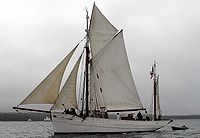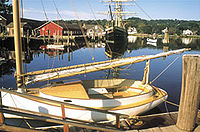Sailboat: Difference between revisions
→Fractional Rig Sloop: Moved image |
|||
| Line 31: | Line 31: | ||
==Hulls== |
==Hulls== |
||
{{main|Hull (watercraft)}} |
{{main|Hull (watercraft)}} |
||
Most sailboats have a [[monohull]], but [[multihull|multi-hull]] catamarans and trimarans are popular. The multihull boats generally do not have keels or centerboards and achieve stability through the broad stance of the multiple hulls. Monohull boats generally rely on a keel or centerboard for horizontal stability, and generally are known as displacement hulls, as they do not plane above the water at speed. However, catamarans and trimarans plane easily making them generally faster than monohulls. All these hull types may also be manufactured as, or outfitted with [[sailing hydrofoil|hydrofoils]]. |
Most sailboats have a [[monohull]], but [[multihull|multi-hull]] catamarans and trimarans are popular. The multihull boats generally do not have keels or centerboards and achieve stability through the broad stance of the multiple hulls. Monohull boats generally rely on a keel or centerboard for horizontal stability, and generally are known as displacement hulls, as they do not plane above the water at speed. However, catamarans and trimarans plane easily making them generally faster than monohulls. All these hull types may also be manufactured as, or outfitted with [[sailing hydrofoil|hydrofoils]].cody whorley was here |
||
==Keel== |
==Keel== |
||
A sailboat's [[keel]] is made effective by a combination of weight, depth and length. Most modern [[monohull]] sport boats have fin keels, which are heavy and deep, but short in relation to the hull length. More traditional yachts carried a full keel which is generally half or more of the length of the boat. A recent feature is a [[winged keel]], which is short and shallow, but carries a lot of weight in two "wings" which run sideways from the main part of the keel. Even more recent is the concept of canting keels, designed to move the weight at the bottom of a sailboat to the upwind side, allowing the boat to carry more sails. |
A sailboat's [[keel]] is made effective by a combination of weight, depth and length. Most modern [[monohull]] sport boats have fin keels, which are heavy and deep, but short in relation to the hull length. More traditional yachts carried a full keel which is generally half or more of the length of the boat. A recent feature is a [[winged keel]], which is short and shallow, but carries a lot of weight in two "wings" which run sideways from the main part of the keel. Even more recent is the concept of canting keels, designed to move the weight at the bottom of a sailboat to the upwind side, allowing the boat to carry more sails. |
||
Revision as of 19:33, 16 February 2007

The term sailboat has a broad meaning generally including yachts, (large sailboats) and smaller vessels of many configurations, which use wind as the primary means of propulsion. Some of the variations other than size are: hull configuration (monohull, catamaran, trimaran), keel type (full, fin, wing, centerboard etc.), purpose (sport, racing, cruising), number and configuration of masts, and the sail plan. Some of the terms below have had various meanings through history, but now have a specific meaning in the parlance of modern yachting. See also the articles on sailing ships and yachts; each of these terms generally describes a larger vessel than a sailboat; however, the distinctions are blurred and the definitions vary by region and culture. At the smaller end, the distinction among, sailboards, windsurfing, and dinghies can be vague.
Sloop

The most common sailboat is the sloop which features one mast and two sails, a normal mainsail and a foresail. This simple configuration is very efficient for sailing towards the wind. The mainsail is attached to the mast and the boom, which is a spar capable of swinging across the boat, depending on the direction of the wind. Depending on the size and design of the foresail it can be called a jib, genoa, or spinnaker; it is possible but not common for a sloop to carry two foresails from the one forestay at one time (wing on wing). The forestay is a line or cable running from near the top of the mast to a point near the bow.
Fractional Rig Sloop

On a fractional rig sloop the forestay does not run to the top of the mast, rather it connects at some point below. This allows the top of the mast to be raked aft by increasing the tension of the backstay, while arching the middle of the mast forward. Without great explanation, this gives a performance advantage in some conditions by flattening the sails. The big mainsail provides most of the drive, and the small headsail is easier for a short-handed crew to manage.
Cutters

The cutter is similar to a sloop with a single mast and mainsail, but generally carries the mast further aft to allow for the use of two headsails attached to two forestays, the head stay and the inner stay, which carry the jib and staysail respectively. This is rarely considered a racing configuration; however, it gives versatility to cruising boats, especially in high wind conditions, when a small jib can be flown from the inner stay.

Catboats
A catboat has a single mast mounted fairly forward and does not carry a head sail (jib etc.). Most modern designs have only one sail, the mainsail; however the traditional catboat could carry multiple sails from the gaff rig.
Ketches
Ketches are similar to a sloop, but there is a second shorter mast to the stern of the mainmast, but forward of the rudder post. The second mast is called the mizzen mast and the sail is called the mizzen sail. A ketch can also be cutter-rigged with two headsails.
Yawl
A yawl is similar to a ketch, with the mizzen mast shorter than the main mast but the mizzen mast is carried astern of the rudder post. Generally the mizzen on a yawl is smaller than the mizzen on a ketch, and is used more for balance than propulsion.

Schooner
A schooner can have two or more masts, but the second mast is at least as tall as the first, distinguishing this design from a ketch or a yawl. Top sail schooners are rigged to carry a square sail near the top of their foremast, but generally modern schooners are gaff or marconi rigged.
Hulls
Most sailboats have a monohull, but multi-hull catamarans and trimarans are popular. The multihull boats generally do not have keels or centerboards and achieve stability through the broad stance of the multiple hulls. Monohull boats generally rely on a keel or centerboard for horizontal stability, and generally are known as displacement hulls, as they do not plane above the water at speed. However, catamarans and trimarans plane easily making them generally faster than monohulls. All these hull types may also be manufactured as, or outfitted with hydrofoils.cody whorley was here
Keel
A sailboat's keel is made effective by a combination of weight, depth and length. Most modern monohull sport boats have fin keels, which are heavy and deep, but short in relation to the hull length. More traditional yachts carried a full keel which is generally half or more of the length of the boat. A recent feature is a winged keel, which is short and shallow, but carries a lot of weight in two "wings" which run sideways from the main part of the keel. Even more recent is the concept of canting keels, designed to move the weight at the bottom of a sailboat to the upwind side, allowing the boat to carry more sails.
Centerboard
The centerboard or daggerboard is in essence a very lightweight keel, which is not permanently mounted and can be pulled up to accommodate shallow water. Some sportsboats are designed to plane on top of the water since they feature centerboards or light keels.


See also
Manufacturers
- List of sailboat designers and manufacturers
- Bavaria Yachtbau
- Beneteau
- Catalina Yachts
- Hunter Marine
- Jeanneau
- Grand Soleil
References and further reading
- Sailboat Information at MadeHow.com Background, History, Raw Materials, Design, The Manufacturing Process, and Quality Control
- Cruising Resources Choosing a cruising sailboat
